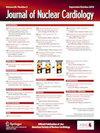接受应激 SPECT 心肌灌注成像的患者中单项体育活动问卷的临床相关性。
IF 2.7
4区 医学
Q2 CARDIAC & CARDIOVASCULAR SYSTEMS
引用次数: 0
摘要
背景:越来越多的人呼吁采用超短运动量问卷作为临床 "生命体征"。迄今为止,这种方法尚未应用于接受心脏负荷测试的患者:我们对 1136 名患者进行了评估,这些患者在接受应激 SPECT 心肌灌注成像(MPI)前填写了一份单项运动问卷。该问题要求患者以 11 分制(0= 没有,10= 经常)对日常生活中的运动量进行评分。根据患者的回答,他们被分为四组:无运动量组、低运动量组、中等运动量组和高运动量组。我们将问卷结果与患者的临床风险状况、压力测试模式(运动与药物)以及运动跑步机持续时间进行了比较:结果:我们发现,运动量与患者的高血压、糖尿病和肥胖症发病率之间存在逐步递减的反向关系(p 结论:我们的单项自我问卷调查结果显示,运动量与患者的高血压、糖尿病和肥胖症发病率之间存在逐步递减的反向关系:我们的单项自我报告问卷与患者的风险概况、压力测试方式和心肺功能相关。这些相关性,加上这份超短问卷的实用性,以及它能识别出可能需要运动咨询的患者,都预示着在接受压力 MPI 和其他心脏成像检查的患者中采用有关运动活动的超短问卷是一个好兆头,因为在这些检查中,功能能力并不是常规评估项目。本文章由计算机程序翻译,如有差异,请以英文原文为准。
Clinical correlates of a single-item physical activity questionnaire among patients undergoing stress SPECT myocardial perfusion imaging
Background
There has been an increasing call for employing ultrashort exercise activity questionnaires as a clinical “vital sign”. To-date, this has not been applied to patients undergoing cardiac stress testing.
Methods
We evaluated 1136 patients who completed a one-item exercise questionnaire before undergoing stress SPECT myocardial perfusion imaging (MPI). This question asked patients to grade how much they exercise during daily life on a 11-point scale (0 = none, 10 = always). Patients were divided into four exercise activity groups based on their response: no, low, moderate, and high exercise activity. The results of this questionnaire were compared with patients’ clinical risk profile, mode of stress testing (exercise vs pharmacologic), and exercise treadmill duration.
Results
We noted a stepwise inverse relationship between exercise activity and patients’ frequency of hypertension, diabetes, and obesity (P < .001 for each). Patients with no reported exercise activity were more likely to complain of dyspnea. There was a stepwise increase in the number of patients performing treadmill exercise with increasing reported exercise activity (P < .001). The duration on treadmill exercise increased in stepwise fashion with higher patient reported exercise activity (P < .001).
Conclusion
Our single-item, self-reported questionnaire was correlated with patients’ risk profiles, their mode of stress testing, and cardiorespiratory fitness. These correlates, along with the pragmatic nature of this ultrashort questionnaire, and its built-in identification of patients who may warrant exercise counseling, augurs for adopting ultrashort questionnaires regarding exercise activity among patients undergoing stress MPI, and other cardiac imaging tests where functional capacity is not routinely assessed.
求助全文
通过发布文献求助,成功后即可免费获取论文全文。
去求助
来源期刊
CiteScore
5.30
自引率
20.80%
发文量
249
审稿时长
4-8 weeks
期刊介绍:
Journal of Nuclear Cardiology is the only journal in the world devoted to this dynamic and growing subspecialty. Physicians and technologists value the Journal not only for its peer-reviewed articles, but also for its timely discussions about the current and future role of nuclear cardiology. Original articles address all aspects of nuclear cardiology, including interpretation, diagnosis, imaging equipment, and use of radiopharmaceuticals. As the official publication of the American Society of Nuclear Cardiology, the Journal also brings readers the latest information emerging from the Society''s task forces and publishes guidelines and position papers as they are adopted.

 求助内容:
求助内容: 应助结果提醒方式:
应助结果提醒方式:


